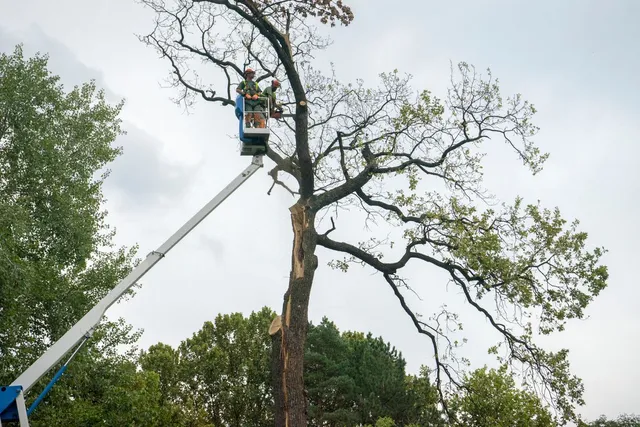Mature shade trees are often considered an asset, increasing property value, providing cooling shade in summer, and giving neighborhoods a welcoming, natural appearance. Trees, however, can become dangerous if their health or structural integrity is compromised. Storms, disease, old age, and improper maintenance can turn beautiful trees into potential hazards. Branches, or even whole trees, can come down suddenly, especially during severe weather events, posing risks to property, vehicles, power lines, and human life. Each year in the U.S., tree failures cause significant injuries and property losses, highlighting the need for ongoing vigilance and care.
Professional care and regular inspections are crucial in minimizing risks and addressing potential problems before they escalate. Working with providers like Tampa Bay Tree Service ensures that inspections and necessary maintenance are conducted by trained professionals who recognize early warning signs of instability or disease. Widespread power outages, fire hazards, and even fatalities are sometimes traced back to tree hazards that could have been prevented with timely intervention. According to the National Fire Protection Association, trees coming into contact with power lines are a leading cause of power disruptions and fire hazards during storms. Healthy, well-maintained trees contribute to a safer, more reliable environment.
Identifying Potential Tree Hazards
Recognizing the early signs of tree distress is vital in preventing accidents. While not all visible symptoms lead to immediate danger, a combination of warning signs warrants quick action. Dead or hanging branches, deep cracks in trunks, split limbs, sudden loss of large limbs, and exposed roots are all classic symptoms that should never be ignored. Bulges, cavities, and fungal growth—such as mushrooms at the base of a tree—often signal decay within the trunk or primary roots, destabilizing the tree over time.
Leaning trees, especially those recently changed angle or whose roots are pulling out of the ground, signal potential catastrophic failure. Environmental stressors like droughts, soil compaction, and insect infestations weaken trees, increasing the likelihood of limb drop or collapse. Due to the increased risk, trees with visible signs of stress or decay should be evaluated more quickly in busy areas. Staying proactive with regular checks allows property owners and communities to manage risks before they evolve into emergencies.
Routine Tree Inspection: What to Look For
Inspecting your trees several times each year allows for early identification of changes in structure and health. The key is consistency—monitoring throughout each season, after heavy storms, or whenever developments on your property could impact nearby root zones. Tree health can change quickly if weakened by storms or disease, so routine checks are fundamental to ongoing safety.
- Check the trunk for new or expanding cracks, splits, or hollows.
- Gauge major branches for signs of sagging, breakage, or detachment.
- Look for fungal growths, such as bracket fungi or mushrooms, at the base—a red flag for internal decay.
- Evaluate for dead or broken limbs, particularly overhanging structures, walkways, or driveways.
- Take stock of any leaning, shifts in the tree’s angle, or visibly uplifted soil around the base.
- Watch for abnormal bark patterns like cankers, peeling, or sunken areas.
- Monitor foliage—premature leaf drop or widespread browning may reflect underlying issues.
Maintaining a simple log of your inspections will help you spot patterns or changes from year to year. A certified arborist should be called to provide a professional assessment and solutions when any significant issue is identified.
Proactive Tree Care Strategies
Proactive, hands-on care is the best way to enhance your trees’ appearance and safety. Pruning in the correct season removes dead or hazardous limbs, reduces overall wind resistance during storms, and can even stimulate healthier, denser foliage. According to leading urban forestry research, regularly pruned trees are less likely to suffer critical failures during extreme weather.
Installation of support systems, such as cabling or bracing, is particularly effective for trees with structurally weak or heavy limbs, offering reinforcement against strong winds or heavy rain. Mulching is invaluable—when applied in a donut around the base, it helps retain moisture, regulate soil temperature, and prevent damaging mower or trimmer contact with bark. Fertilization should only be prescribed following a soil test, as over-fertilizing can harm established trees while undersupplying key nutrients slows growth and resilience.
Deep, slow watering during drought helps trees build robust root systems that anchor them firmly in the ground. Avoiding construction or soil compaction close to primary roots, particularly during landscaping projects, is essential. An ounce of attention spent now on strengthening and protecting trees can save significant time and expense.
Working With Experts
While basic visual inspections are applicable, engaging a professional arborist brings invaluable expertise and diagnostic tools. Arborists utilize techniques such as resistograph testing to probe for hidden decay, sonic tomography to detect internal cavities, and advanced visual assessments to evaluate overall tree stability. Such assessments are rarely possible for the average property owner, making the arborist’s role critical in developing long-term health and risk management plans.
The Trees Are Good educational network guides on why and how trees are integral to our communities and the importance of seeking professional help. Certified professionals provide recommendations tailored to each landscape’s unique conditions, species, and environments. Arborists aren’t just emergency responders—they are long-term partners in safety, helping you plan for replacements, assess post-storm or post-construction stability, and address potential risks before they manifest into actual hazards.
Involving the Community in Tree Safety
Tree safety extends beyond property lines. The risk is multiplied in neighborhoods—one risky limb can threaten adjacent homes, a busy sidewalk, or a local playground. Proactive communities often organize educational events such as tree walks or workshops, where residents learn to identify warning signs and report concerns to the proper authorities. In many cities, local tree ordinances, homeowner associations, or municipal departments facilitate regular checks and maintenance on public trees.
Programs that encourage neighbors to share what they observe—broken limbs, sudden falls, or signs of disease—empower faster, community-wide hazard mitigation. Municipalities benefit by maintaining updated tree inventories, mapping high-risk areas, and prioritizing repairs and scheduled trims. The result is safer streets and shared spaces, enhanced property values, and a stronger sense of neighborhood pride and responsibility.
- Coordinate neighborhood watch groups to monitor trees after storms.
- Share resources, like contact information for local arborists or city maintenance hotlines.
- Support or initiate annual community tree audits, especially in older, tree-lined neighborhoods.
Preparing Trees for Storms and Extreme Weather
Storms are one of the leading causes of tree-related property damage, but careful preparation lessens the blow. Early action is crucial in areas prone to hurricanes, tornadoes, or even severe thunderstorms. The most effective tactics include diligent pruning to eliminate deadwood and relieve excessive canopy density, which keeps trees more aerodynamic during high winds. Removing branches that dangle over structures or power lines further prevents avoidable losses.
Before storm season, secure landscape items—such as benches, potted plants, or garden features—that could be picked up and hurled by winds, potentially hitting trees and causing wounds or snap-offs. For large or questionable trees, professional assessment for bracing or, if needed, preemptive removal is sometimes necessary to prevent future disaster. The National Weather Service provides extensive resources on severe weather preparedness, with checklists and updates to guide families and whole communities. After significant storms, inspect trees when they are safe, and watch for split branches, leaning trunks, or exposed roots.
Final Thoughts on Tree Hazard Prevention
Investing in ongoing tree care is one of the most reliable ways to protect your property, loved ones, and community. From the smallest courtyard ornamentals to the grandest old oaks, every tree depends on people to notice, nurture, and intervene when risks arise. Everyone can share the benefits of robust, safe trees by performing regular inspections, adopting proactive management habits, relying on expert advice, and fostering community involvement. Prevention is the cornerstone of safety—a philosophy that ensures trees remain valued assets for years instead of looming hazards for tomorrow.

